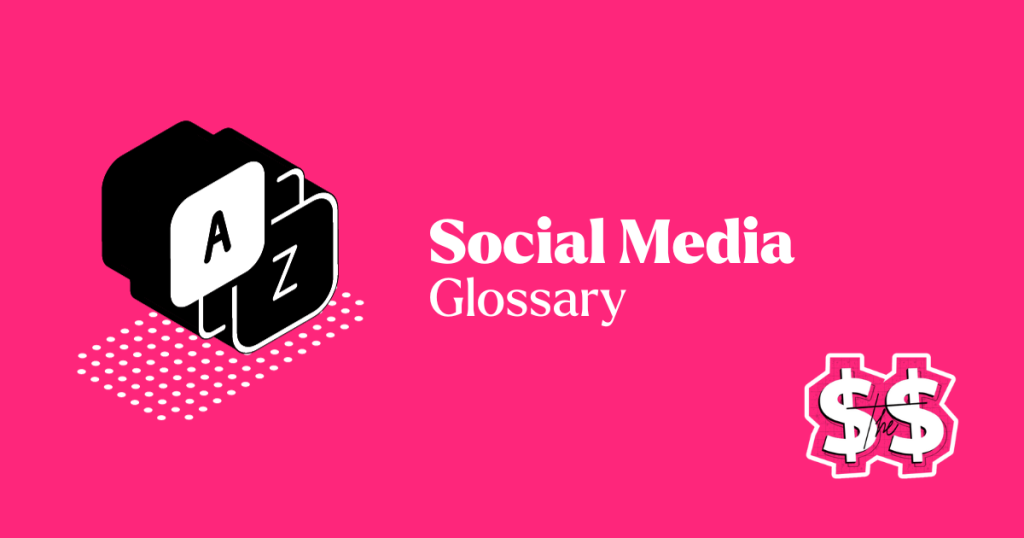Social Media is represented by online platforms and websites that allow users to create, share, and interact with content, facilitating real-time communication, fostering communities around shared interests, and shaping global conversations on a diverse range of topics.
- Social Media: Online platforms and websites that allow users to create, share, and interact with content.
- Social Network: A platform that connects individuals or groups with shared interests or activities.
- Social Media Marketing (SMM): The use of social media platforms for marketing and promotion. (ref.: marketing glossary)
- Algorithm: The set of rules determining the content shown to users on their social media feeds.
- Feed: The continuous stream of content displayed on a user’s social media homepage.
- Handle: A user’s unique name or identifier on social media, often preceded by the “@” symbol.
- Profile: An individual’s or business’s personal space on a social media platform.
- Timeline: A chronological display of a user’s posts and activity on a social media profile.
- Engagement: Interaction and participation with content, including likes, comments, and shares.
- Reach: The total number of people who see a particular piece of content.
- Impressions: The total number of times a piece of content is displayed, regardless of engagement.
- Viral: Content that spreads rapidly and widely across social media platforms.
- Influencer: A person with a significant following on social media, often partnering with brands for promotion.
- Follower: A user who subscribes to another user’s updates on a social media platform.
- Hashtag (#): A metadata tag used to categorize content and make it discoverable.
- Trending: Topics, hashtags, or content gaining widespread popularity on social media.
- Emoji: Small digital images or icons used to convey emotions or ideas in messages.
- Geotagging: Adding a location to a social media post, providing context about where it was created.
- DM (Direct Message): Private messages sent between users on social media platforms.
- Like: A positive interaction with a piece of content, often represented by a heart icon.
- Comment: User-generated responses to social media posts.
- Share/Retweet/Repost: Distributing someone else’s content to your own followers.
- Meme: Humorous images, videos, or texts that spread rapidly on social media.
- Filter: Digital effects applied to photos or videos to enhance or alter their appearance.
- Story: Temporary content that disappears after a set period, often used for more casual updates.
- Live Video: Real-time video broadcasting on social media platforms.
- Analytics: Tools and data providing insights into social media performance and audience behavior.
- Social Listening: Monitoring and analyzing online conversations to understand public sentiment.
- UGC (User-Generated Content): Content created by users rather than brands.
- Caption: Text accompanying an image or video, providing context or additional information.
- Tagging: Associating a user or another entity with a piece of content.
- Brand Advocacy: Encouraging satisfied customers to promote a brand on social media.
- Carousel: A format allowing multiple images or videos in a single social media post.
- Chatbot: Automated programs designed to simulate conversation with users.
- Dark Social: Private sharing of content that cannot be tracked through traditional analytics.
- Community Manager: A person responsible for engaging with an online community on behalf of a brand.
- Verified Badge: An icon indicating that a social media account is authentic and official.
- Privacy Settings: Controls allowing users to manage who can view their content.
- Scheduling: Planning and automating the posting of social media content in advance.
- Social Media Calendar: A schedule outlining planned content and campaigns across platforms.
- A/B Testing: Experimenting with variations of content to determine which performs better.
- Impersonation: Pretending to be another person or entity on social media, often for deceptive purposes.
- Social Media Crisis: A situation where negative information or backlash spreads rapidly on social media.
- Facebook: A leading social networking platform allowing users to connect and share content. (ref.: Facebook glossary)
- Instagram: A photo and video sharing platform known for its visual-centric content. (ref.: Instagram glossary)
- Twitter: A microblogging platform where users share short messages called tweets. (ref.: Twitter glossary)
- LinkedIn: A professional networking platform connecting individuals and businesses.
- YouTube: A video-sharing platform where users can upload, view, and share videos. (ref.: YouTube glossary)
- Snapchat: A multimedia messaging app known for its disappearing content. (ref.: Snapchat glossary)
- TikTok: A short-form video platform where users create and share engaging videos. (ref.: TikTok glossary)
- Pinterest: A visual discovery platform where users discover and save ideas. (ref.: Pinterest glossary)
- Reddit: A community-driven platform where users submit and discuss content. (ref.: Reddit glossary)
- Tumblr: A microblogging platform with a focus on multimedia content.
- WhatsApp: A messaging app for text, voice, and video communication.
- Vero: A social network emphasizing a chronological feed and no ads.
- Quora: A platform for asking questions and connecting with people who contribute unique insights. (ref.: Quora glossary)
- Yelp: A platform for user-generated reviews and recommendations for businesses.
- Periscope: A live video streaming app integrated with Twitter.
- KPI (Key Performance Indicator): Metrics used to evaluate the effectiveness of social media efforts.
- Gamification: Applying game elements to non-game contexts, often used in social media engagement.
- FOMO (Fear of Missing Out): The anxiety that others are experiencing rewarding events and one is missing out.
- Emoji Marketing: Incorporating emojis into marketing messages for added expression.
- Augmented Reality (AR): Technology that overlays digital information on the real world, often used in filters.
- Facebook Groups: Community spaces within Facebook where users with similar interests can connect.
- Chat Stickers: Stickers used in messaging apps for added expression.
- Snap Map: A feature on Snapchat allowing users to share their location on a map.
- Shadowban: Restricting a user’s visibility on a platform without their knowledge.
- Memetic Marketing: Leveraging memes for marketing purposes.
- Crisis Response: A brand’s strategy for addressing negative situations or crises on social media.
- Vlogging: Creating content in a video blog format, often sharing personal experiences.
- Ephemeral Content: Content that is temporary and disappears after a short period.
- Social Commerce: Integrating e-commerce features into social media platforms.
- Cohort Analysis: Analyzing groups of users who share similar characteristics or experiences.
- API (Application Programming Interface): A set of rules allowing different software applications to communicate with each other.
- Tag Management System (TMS): A tool simplifying the process of managing tags on a website.
- Reddit AMA (Ask Me Anything): An interactive interview format on Reddit where users can ask questions.
- Podcasting: Creating and sharing audio content in episodic form.
- Snap Originals: Exclusive shows produced by Snapchat for its users.
- Micro-Influencer: An influencer with a moderate but highly engaged and niche-specific audience, typically ranging from a few thousand to tens of thousands of followers on social media platforms.

Social Media Marketing is a strategic approach that leverages social media platforms to connect with a target audience, build brand awareness, and drive engagement. Through compelling content, targeted ads, and community interaction, businesses aim to enhance their online presence, foster customer relationships, and achieve marketing goals in the dynamic landscape of social media.
